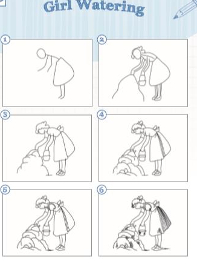The Draw Vintage Images series consists of five books (in both print and PDF format) that gradually teach drawing skills. The title includes the word “vintage” since many of the drawings are inspired by images such as you would see in books from the 1950s and earlier. The levels for each book do not indicate grade levels, but increasing levels of difficulty.
All of the books teach only by showing visual step-by-step additions to create each drawing. The number of panels showing the steps varies to suit each subject as well as the level of each book. The first book teaches how to draw many simple items, but it breaks the steps down into more panels with fewer details added to each than we find in subsequent books. There is no explanatory text, and it’s not needed most of the time, although text explaining techniques such as shading might be helpful. Students will need only a standard #2 pencil, a kneaded eraser, and sketch paper.
The overall approach is to help students learn to draw realistically, although some drawings do not make their subjects appear three dimensional or realistic. This is not like drawing courses that teach students how to draw animals using geometric shapes, creating only flat, artificial images.
Level 1, the first book, uses relatively simple straight and curved lines. Some items are drawn at an angle to give a three-dimension appearance, so students learn to draw from something other than a front-on visual perspective. The progression within each book doesn’t necessarily build step by step. For example, in the first book children learn to draw a teapot that looks three-dimensional before drawing a flat image of a rainbow with clouds.
Level 2 teaches slightly more complex drawings such as an open book with an image of a bird on one of its pages, two coffee cups stacked at odd angles, and window drapes with wavy lines to indicate gathers at the top and the flow of fabric in folds.
The third book is quite a bit more difficult than the first two. Many drawings are complex, such as landscapes with both figures and objects, and drawing with overlapping objects. Students learn to draw people in both cartoonish and realistic forms. Extensive shading is used, as in a drawing of an open grand piano.
Level 4 starts out at a very challenging level with a landscape drawing that shows the backs of two girls, with one of the girls dangling a cat from each of her arms and the other with a cat sleeping on her shoulder─quite complex! Almost every drawing includes people. While the majority of drawings in the previous books presented all of the panels for each drawing on only one page, the panels for many of the drawings in this book take two pages. The extra page is needed since each panel is larger to clearly show all of the details in the drawings.
In Level 5, people are placed within more landscapes that are more complex, items are drawn at more extreme angles, and a number of drawings include horses and dogs.
Students will learn drawing techniques as they work through the various lessons. While they don’t learn terms such as foreshortening and perspective, they learn these and other techniques as they work through each drawing exercise. The publisher, The Good and the Beautiful, does not show recommended grade levels for these books. Students vary greatly in their ability to copy drawings accurately, so you will have to judge for yourself when a child is ready for this series. I would say that unless a student already has learned at least some realistic drawing techniques, I would start with Level 1. Even if they breeze through this level, they will be learning techniques and growing in confidence before they hit the more challenging levels.









